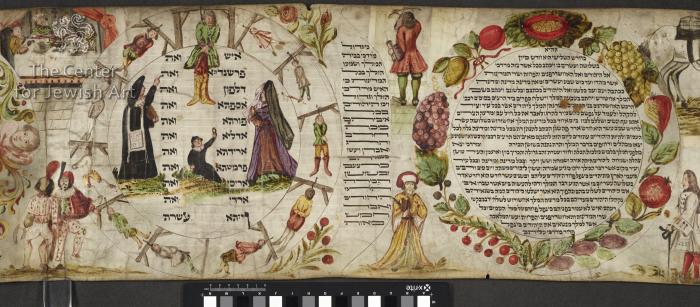Obj. ID: 36154 JRL Esther Scroll with Roundels, Austria (?), mid-18th century

Length of the sheets in the scroll: 1) 425 mm, 2) 700 mm, 3) 695 mm, 4) 690 mm, 5) 730 mm, 6) ca. 675 mm.
Dimensions of the selected details in the scroll:
- an average roundel outside: 280 mm;
- an average roundel inside: 207 mm;
- an average letter: 3 mm;
- spaces between the lines of the text: 5 mm.
The manuscript lacks its opening section but the remaining part of the manuscript is preserved in good condition.
The decoration is quite well preserved and the text is in perfect condition.
The sheets are rather dirty and dark; this concerns especially the opening and final parts of the scroll.
On the first membrane, some white stains are visible.
In this richly decorated megillah, a variety of motifs in a unique arrangement fills all the available space on each membrane. The Hebrew text of the Book of Esther is written within mostly circular text panels, though the shapes of the circles do differ slightly. The "rings" are formed of flowers (e.g. carnations, roses, tulips, and lilies), fruits (e.g. apple, pear, grape bunches, blackberries), fruiting trees in pots, elaborate acanthus leaves, birds (mainly colorful parrots), angels' heads, and signs of the Zodiac. Most uniquely, the text Haman's sons by name (Es. 9:6-10) is surrounded by small gallows. The spaces between the roundels are filled with illustrations from the Book of Esther and its midrashim, as well as portraits of the Purim story's protagonists. Some decorations are not directly related to the Esther narrative. The manuscript is incomplete.
The Book of Esther in Hebrew but the text is incomplete; currently, it starts at Es. 2:7.
The scroll is formed of 6 sheets containing 13 text panels in total with 21-24 lines each, except for roundel 11 which has 11 lines divided into two half-columns.
The text between roundels 9 and 11 is not written within a roundel but a very narrow column.
The text is written in Hebrew Ashkenazi script with tagin in black ink on the parchment membranes of medium thickness but rather stiff, suede, and dark.
The length of the lines of the text differs so they fit the space in the roundels.
The letter ת (Es. 9:29) is highlighted by its size. Enlarged and diminished letters are included in roundel 11.
The highlighted letters of the Tetragrammaton are marked in roundels 1 and 3.
The ruling - made with a hard point - along with the breaks between membranes is visible.
The pricking is visible on the sheets' edges.
The membranes in the scroll are glued together.
None
The details suggest that the text was penned and decorated by the same person.
The decoration of the scroll shows some common features with the Book of Psalms of 1706 by Shabetai Scheftel ben Zalman Auerbach and Esther scroll C-325 from the JHI collection in Warsaw (see "Related objects").
In the scroll, figures in the biblical narrative are depicted as belonging to the higher social class of the artist’s day. These possibly represent court Jews, who could also be patrons and users of these manuscripts.
The scroll is discussed in:
Dagmara Budzioch, The Decorated Esther Scrolls from the Museum of the Jewish Historical Institute in Warsaw and the Tradition of Megillot Esther Decoration in the Seventeenth and Eighteenth Centuries – An Outline [Polish: Dekorowane zwoje Estery z Żydowskiego Instytutu Historycznego w Warszawie na tle tradycji dekorowania megilot Ester w XVII i XVIII wieku. Zarys problematyki], Warsaw 2019, 1:248-272.
Its images (nos. JRL16052165-JRL16052169) are available on https://luna.manchester.ac.uk (accessed on 28.10.2020).






